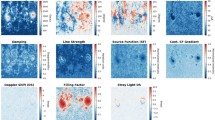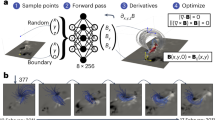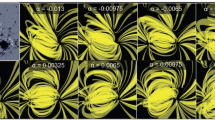Abstract
We explore the application of neural fields for tomographic reconstructions of the solar corona using data from the Large Angle and Spectrometric Coronagraph (LASCO)-C2 instrument. We first demonstrate their ability to recover the electron-density volume in a synthetic static case, utilizing a simulated 3D model of the corona. Our results show that neural fields provide an efficient and accurate representation of the electron-density data. By comparing the synthesized polarized brightness from the modeled electron densities and the observations, we validate the performance of the method in recovering the electron-density structure accurately. Furthermore, we extend our analysis to the dynamic case, considering time-dependent reconstructions. To this end, we incorporate the temporal dimension into the neural field. The results demonstrate that neural fields can effectively capture the temporal variability of the coronal electron density. We apply the developed tomographic strategy to real observations from the LASCO-C2 instrument. Using a sequence of LASCO-C2 images, we reconstruct the electron-density distribution of the solar corona for a specific period. The reconstructed electron densities are able to reproduce the observed features of the polarized brightness with fidelity, although some streamers are not properly fitted. The results indicate that neural fields provide a powerful tool for tomographic reconstructions, yielding electron-density maps with minimal artifacts and improved agreement with observations. Neural fields offer several advantages, including efficient interpolation, easy to implement implicit and explicit regularization, and the ability to capture temporal variability. The proposed approach has the potential to enhance our understanding of the complex dynamics and structures of the solar corona, enabling more accurate and detailed analyses of coronal features.









Similar content being viewed by others
Data Availability
Data, together with training and evaluation scripts, are available at https://github.com/aasensio/nf_corona.
References
Asensio Ramos, A., Díaz Baso, C.J., Kochukhov, O.: 2022, Approximate Bayesian neural Doppler imaging. Astron. Astrophys. 658, A162. DOI. ADS.
Billings, D.E.: 1966, A guide to the solar corona. ADS.
Bintsi, K.-M., Jarolim, R., Tremblay, B., Santos, M., Jungbluth, A., Mason, J.P., Sundaresan, S., Vourlidas, A., Downs, C., Caplan, R.M., Muñoz Jaramillo, A.: 2022, SuNeRF: Validation of a 3D Global Reconstruction of the Solar Corona Using Simulated EUV Images. ArXiv e-prints. arXiv. DOI. ADS.
Butala, M.D., Hewett, R.J., Frazin, R.A., Kamalabadi, F.: 2010, Dynamic three-dimensional tomography of the solar corona. Solar Phys. 262, 495. DOI. ADS.
Casini, R., Judge, P.G.: 1999, Spectral lines for polarization measurements of the coronal magnetic field. II. Consistent treatment of the Stokes vector forMagnetic-dipole transitions. Astrophys. J. 522, 524. DOI. ADS.
Collette, A.: 2013, Python and HDF5 O’Reilly.
Cranmer, S.R., Kohl, J.L., Noci, G., Antonucci, E., Tondello, G., Huber, M.C.E., Strachan, L., Panasyuk, A.V., Gardner, L.D., Romoli, M., Fineschi, S., Dobrzycka, D., Raymond, J.C., Nicolosi, P., Siegmund, O.H.W., Spadaro, D., Benna, C., Ciaravella, A., Giordano, S., Habbal, S.R., Karovska, M., Li, X., Martin, R., Michels, J.G., Modigliani, A., Naletto, G., O’Neal, R.H., Pernechele, C., Poletto, G., Smith, P.L., Suleiman, R.M.: 1999, An empirical model of a polar coronal hole at solar minimum. Astrophys. J. 511, 481. DOI. ADS.
Crifo-Magnant, F., Picat, J.P.: 1980, A density model for the North polar coronal hole at the 1973 eclipse. Astron. Astrophys. 88, 97. ADS.
Frazin, R.A., Janzen, P.: 2002, Tomography of the solar corona. II. Robust, regularized, positive estimation of the three-dimensional electron density distribution from LASCO-C2 polarized white-light images. Astrophys. J. 570, 408. DOI. ADS.
Frazin, R.A., Kamalabadi, F.: 2005, Rotational tomography for 3d reconstruction of the white-light and euv corona in the post-soho era. Solar Phys. 228, 219. DOI. ADS.
Frazin, R.A., Vásquez, A.M., Kamalabadi, F.: 2009, Quantitative, three-dimensional analysis of the global corona with multi-spacecraft differential emission measure tomography. Astrophys. J. 701, 547. DOI. ADS.
Frazin, R.A., Vásquez, A.M., Kamalabadi, F., Park, H.: 2007, Three-dimensional tomographic analysis of a high-cadence LASCO-C2 polarized brightness sequence. Astrophys. J. 671, L201. DOI.
Frazin, R.A., Lamy, P., Llebaria, A., Vásquez, A.M.: 2010, Three-dimensional electron density from tomographic analysis of LASCO-C2 images of the K-corona total brightness. Solar Phys. 265, 19. DOI. ADS.
Harris, C.R., Millman, K.J., van der Walt, S.J., Gommers, R., Virtanen, P., Cournapeau, D., Wieser, E., Taylor, J., Berg, S., Smith, N.J., Kern, R., Picus, M., Hoyer, S., van Kerkwijk, M.H., Brett, M., Haldane, A., Fernández del Río, J., Wiebe, M., Peterson, P., Gérard-Marchant, P., Sheppard, K., Reddy, T., Weckesser, W., Abbasi, H., Gohlke, C., Oliphant, T.E.: 2020, Array programming with NumPy. Nature 585, 357. DOI.
Huang, X., Ye, Z., Liu, H., Shi, B., Wang, Z., Yang, K., Li, Y., Weng, B., Wang, M., Chu, H., et al.: 2021, Meta-Auto-Decoder for Solving Parametric Partial Differential Equations. ArXiv preprint. arXiv.
Hunter, J.D.: 2007, Matplotlib: a 2D graphics environment. Comput. Sci. Eng. 9, 90.
Jarolim, R., Bintsi, M., Santos, M., Tremblay, B., Jungbluth, A., Mason, J.P., Munoz-Jaramillo, A., Sundaresan, S., Vourlidas, A.: 2022, 3D reconstructions of the solar atmosphere using neural radiance fields. In: AGU Fall Meeting Abs. 2022, SH45D. ADS.
Kaiser, M.L., Kucera, T.A., Davila, J.M., St.Cyr, O.C., Guhathakurta, M., Christian, E.: 2008, The STEREO mission: an introduction. Space Sci. Rev. 136, 5. DOI. ADS.
Kingma, D.P., Ba, J.: 2014, Adam: a Method for Stochastic Optimization. ArXiv e-prints. arXiv.
Kramar, M., Inhester, B., Lin, H., Davila, J.: 2013, Vector tomography for the coronal magnetic field. II. Hanle effect measurements. Astrophys. J. 775, 25. DOI. ADS.
Lionello, R., Linker, J.A., Mikić, Z.: 2008, Multispectral emission of the sun during the first whole sun month: magnetohydrodynamic simulations. Astrophys. J. 690, 902. DOI.
Mildenhall, B., Srinivasan, P.P., Tancik, M., Barron, J.T., Ramamoorthi, R., Ng, R.: 2020, Nerf: representing scenes as neural radiance fields for view synthesis. In: European Conference on Computer Vision, Springer, Berlin, 405.
Minnaert, M.: 1930, On the continuous spectrum of the corona and its polarisation. With 3 figures. (Received July 30, 1930. Z. Astrophys. 30, 209. ADS.
Morgan, H.: 2015, Astrophys. J. Suppl. 219, 23. DOI.
Morgan, H.: 2019, An atlas of coronal electron density at 5R ⊙. II. a spherical harmonic method for density reconstruction. Astrophys. J. Suppl. 242, 3. DOI. ADS.
Munro, R.H., Jackson, B.V.: 1977, Physical properties of a polar coronal hole from 2 to 5 R sun. Astrophys. J. 213, 874. DOI. ADS.
Paszke, A., Gross, S., Massa, F., Lerer, A., Bradbury, J., Chanan, G., Killeen, T., Lin, Z., Gimelshein, N., Antiga, L., Desmaison, A., Kopf, A., Yang, E., DeVito, Z., Raison, M., Tejani, A., Chilamkurthy, S., Steiner, B., Fang, L., Bai, J., Chintala, S.: 2019, PyTorch: an imperative style, high-performance deep learning library. In: Wallach, H., Larochelle, H., Beygelzimer, A., d’é-Buc, F., Fox, E., Garnett, R. (eds.) Advances in Neural Information Processing Systems 32, Curran Associates, Red Hook, 8024. http://papers.neurips.cc/paper/9015-pytorch-an-imperative-style-high-performance-deep-learning-library.pdf.
Quémerais, E., Lamy, P.: 2002, Two-dimensional electron density in the solar corona from inversion of white light images – application to SOHO/LASCO-C2 observations. Astron. Astrophys. 393, 295. DOI. ADS.
Rahaman, N., Baratin, A., Arpit, D., Draxler, F., Lin, M., Hamprecht, F., Bengio, Y., Courville, A.: 2019, On the spectral bias of neural networks. In: Chaudhuri, K., Salakhutdinov, R. (eds.) Proc. Machine Learning Res., PMLR 97, 5301. https://proceedings.mlr.press/v97/rahaman19a.html.
Riley, P., Lionello, R., Linker, J.A., Cliver, E., Balogh, A., Beer, J., Charbonneau, P., Crooker, N., DeRosa, M., Lockwood, M., Owens, M., McCracken, K., Usoskin, I., Koutchmy, S.: 2015, Inferring the structure of the solar corona and inner heliosphere during the Maunder minimum using global thermodynamic magnetohydrodynamic simulations. Astrophys. J. 802, 105. DOI. ADS.
Sitzmann, V., Martel, J., Bergman, A., Lindell, D., Wetzstein, G.: 2020, Implicit neural representations with periodic activation functions. Adv. Neural Inf. Process. Syst. 33, 7462.
Tancik, M., Srinivasan, P., Mildenhall, B., Fridovich-Keil, S., Raghavan, N., Singhal, U., Ramamoorthi, R., Barron, J., Ng, R.: 2020, Fourier features let networks learn high frequency functions in low dimensional domains. Adv. Neural Inf. Process. Syst. 33, 7537.
The SunPy Community Barnes, W.T., Bobra, M.G., Christe, S.D., Freij, N., Hayes, L.A., Ireland, J., Mumford, S., Perez-Suarez, D., Ryan, D.F., Shih, A.Y., Chanda, P., Glogowski, K., Hewett, R., Hughitt, V.K., Hill, A., Hiware, K., Inglis, A., Kirk, M.S.F., Konge, S., Mason, J.P., Maloney, S.A., Murray, S.A., Panda, A., Park, J., Pereira, T.M.D., Reardon, K., Savage, S., Sipőcz, B.M., Stansby, D., Jain, Y., Taylor, G., Yadav, T., Rajul, D.T.K.: 2020, The SunPy project: open source development and status of the version 1.0 core package. Astrophys. J. 890. DOI.
Tomczyk, S., Card, G.L., Darnell, T., Elmore, D.F., Lull, R., Nelson, P.G., Streander, K.V., Burkepile, J., Casini, R., Judge, P.G.: 2008, An instrument to measure coronal emission line polarization. Solar Phys. 247, 411. DOI. ADS.
van de Hulst, H.C.: 1950, The electron density of the solar corona. Bull. Astron. Inst. Neth. 11, 135. ADS.
Vibert, D., Peillon, C., Lamy, P., Frazin, R.A., Wojak, J.: 2016, Time-dependent tomographic reconstruction of the solar corona. Astron. Comput. 17, 144. DOI. https://www.sciencedirect.com/science/article/pii/S2213133716301019.
Wang, S., Wang, H., Perdikaris, P.: 2021, On the eigenvector bias of Fourier feature networks: from regression to solving multi-scale PDEs with physics-informed neural networks. Comput. Methods Appl. Mech. Eng. 384, 113938. DOI. https://www.sciencedirect.com/science/article/pii/S0045782521002759.
Acknowledgments
I thank R. Frazin for useful discussions during the initial phases of this work. I acknowledge the community effort devoted to the development of the following open-source packages that were used in this work: numpy (numpy.org, Harris et al., 2020), matplotlib (matplotlib.org, Hunter, 2007), PyTorch (pytorch.org, Paszke et al., 2019), SunPy (sunpy.org, The SunPy Community Barnes et al., 2020), and h5py (Collette, 2013).
Funding
This work was supported by the State Research Agency (AEI) of the Spanish Ministry of Science, Innovation and Universities (MCIU) and the European Regional Development Fund (FEDER) under a grant with reference PGC2018-102108-B-I00.
Author information
Authors and Affiliations
Contributions
A.A.R. did all the work.
Corresponding author
Ethics declarations
Competing interests
The authors declare no competing interests.
Additional information
Publisher’s Note
Springer Nature remains neutral with regard to jurisdictional claims in published maps and institutional affiliations.
Rights and permissions
Springer Nature or its licensor (e.g. a society or other partner) holds exclusive rights to this article under a publishing agreement with the author(s) or other rightsholder(s); author self-archiving of the accepted manuscript version of this article is solely governed by the terms of such publishing agreement and applicable law.
About this article
Cite this article
Asensio Ramos, A. Tomographic Reconstruction of the Solar K-Corona Using Neural Fields. Sol Phys 298, 135 (2023). https://doi.org/10.1007/s11207-023-02226-2
Received:
Accepted:
Published:
DOI: https://doi.org/10.1007/s11207-023-02226-2




